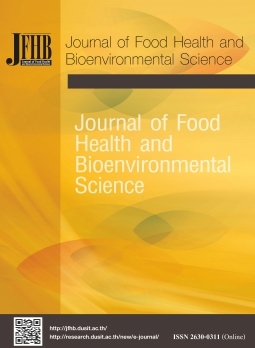Effects of Components on Qualities of Crispy Bamboo Shoot Snack
Keywords:
Crispy snack, Bamboo shoot, Tapioca flourAbstract
The objective of this research was to study the effect of ingredients on the quality of crispy bamboo shoot snack. The effects of different ratios of tapioca flour and bamboo shoots on the quality of crispy bamboo shoot snack were studied. It was found that the optimum ratio of tapioca flour and bamboo shoot was 50:50. It had good appearance and swelling rate after frying. Moreover, the aroma of bamboo shoots was clear. The effects of different flour types on the quality of crispy bamboo shoot snack were investigated. It was found that tapioca flour was suitable flour for crispy bamboo shoot snack production. It had good appearance and swelling rate after frying that it was higher than the formula using glutinous rice flour, rice flour and wheat flour. In addition, the texture of the crispy bamboo shoot snack was crispy at an appropriate level. The effects of flavoring with various flavors on the sensory acceptance of consumers were investigated. The original, seaweed mixed with black sesame and spicy flavors had a higher score in appearance, flavor, taste, texture and overall liking score than other flavors. The analysis of the chemical composition of crispy bamboo shoot snack was investigated. The moisture, protein, fat, total carbohydrate, ash, and energy were 2.73-3.50 %, 1.04-2.39 %, 26.91-28.53 %, 66.36- 66.67 %, 1.89-1.98 % and 513.08-523.81 kcal, respectively. It can be used as a guideline for crispy bamboo shoot snack production for commercial distribution.
References
Association of Official Analytical Chemists. (2012). Official methods of analysis (19th ed.). Washington, D.C.: Author.
Bal, L.M., Kar, A., Satya, S., & Naik, S.N. (2011). Kinetics of colour change of bamboo shoot slices during microwave drying. Journal of Food Science and Technology, 46, 827–833.
BeMiller, J.N., &Whistler, R.L. (2009). Starch : Chemistry and technology. London: Academic Press.
Brufau, G., Canela, M.A., & Rafecas, M. (2008). Phytosterols: Physiologic and metabolic aspects related to cholesterol-lowering properties. Nutrition Research, 28, 217-225.
Chongtham, N., Bisht, M.S., & Haorongbam, S. (2011). Nutritional properties of bamboo shoots: Potential and prospects for utilization as a health food. Comprehensive Reviews in Food Science and Food Safety, 10, 153-169.
Damondaran, S., & Parkin, K.L. (2017). Fennema's Food Chemistry. Florida: CRC Press,Taylor &. Francis Group.
Fellows, P.J. (2017). Food Processing Technology: Principle and Practice. Uxbridge: Woodhead Publishing.
Kengkhetkit, N., Mopoung, R., Tassanaudom, U., & Yodphet, A. (2019). Effect of wheat flour content on characteristics of spicy fermented fish paste crackers. NSRU Science and Technology Journal, 11, 1-14.
Khaepimyi, N., & Nepthangdee, P. (2018). Consumer satisfaction per craker mushroom products. Retrieved November 16, 2020, from https://dspace.bru.ac.th
Kotoki, D., & Deka, S.C. (2010). Baking loss of bread with special emphasis on increasing water holding capacity. Journal of Food Science and Technology, 47, 128-131.
Mogkhuntod, S., Denrungruang, P., & Chitchak, C. (2017). Nutrients and toxins in the bamboo shoots. Retrieved November 16, 2020, from http://forprod.forest.go.th
Nirmala, C., David, E., & Sharma, M.L. (2007). Changes in nutrient components during ageing of emerging juvenile bamboo shoots. International Journal of Food Sciences and Nutrition, 58, 345–352.
Rattanathammawat, R., Suwonsichon, T., Chompreda, P., Sriroth, K., & Haruthaithanasan, V. (2003). Effect of moisture content of half-snacks and frying time on physicochemical properties of taro flour snack. Retrieved November 16, 2020, from http://www.lib.ku.ac.th/KUCONF/KC4106006.pdf
Suriya, P., Thamaragsa, N., Kaewtein, S., Pocarat, R., & Arkanit, K. (2011). Product development of Burma bean chip. In The 2nd MJU-Phrae National Research Conference (pp. 276-283). Phrae: Maejo University Phrae Campus.
Tangkanakul, P. (2003). Making cracker as a quality product. Food, 33, 90-93.
Tantasuttikul, A., & Samuankid, N. (2014). Development of seasoning fish cracker. Rajabhat Agriculture Journal, 13, 71-79.
Thai industrial standards institute. (2006). Community product standards: Crispy snack, khaogriab (107/2554). Retrieved November 16, 2020, from http://tcps.tisi.go.th/pub/tcps107_54.pdf
Tiwthao, O. (2014). Study of salmon skin puffing by microwave oven and frying (Master’s Thesis). Retrieved November 16, 2020, from http://kb.psu.ac.th/psukb/bitstream/2010/10010/1/388040.pdf
Wongsudaluk, W. (2016). Application of champedak (Artocarpus integer) seed flour in cracker product. Retrieved November 16, 2020, from http://ird.skru.ac.th/RMS/file/21388.pdf
Downloads
Published
How to Cite
Issue
Section
License

This work is licensed under a Creative Commons Attribution-NonCommercial-NoDerivatives 4.0 International License.








